How many times have you said, "I wish I had a camera" or "I want to start taking pictures?"
What do you love to spend free time doing? What energizes you to wake up early? Stay longer than planned? Answer these questions and you may find your inspiration.
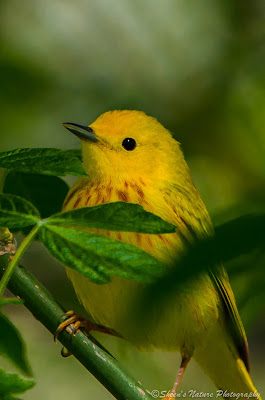 |
Yellow Male Warbler "Hide & Seek"
Nikon 5100, 70-300mm f/6.3, ISO 500 1/1000th sec |
For years I've studied birds through binoculars to get close-up views of these spritely, colorful beauties. On a few excursions, a friend brought her camera. Each time she did, I mumbled "I wish I had a camera."
It was Christmas 2011 when my husband surprised me with a
Nikon kit that had 2 lenses. I must have looked at him funny because he smiled and said, "You've been wanting a camera for years." I was thrilled!
And yet, it sat in a box for three weeks. In early 2012, I pulled my camera out and took five pictures of a chickadee. It looked like a tiny bird on a branch. Back in the box, it wasn't used it again for a few months.
So what in the heck was my problem? A bird lover and nature enthusiast, I had always wanted a camera.
The reality was I didn't want to start at the beginning. I wanted to capture bird images that reflected their details, their expressions. Details of flowers, brilliant color hues, soft backgrounds were desired state. The term 'depth of field' was foreign but I wanted that soft, 'blurred look" complementing the focal point.
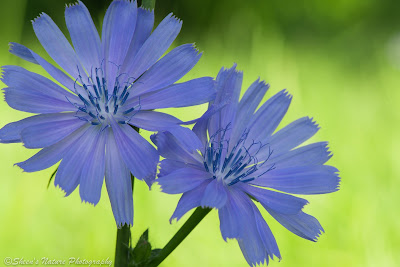 |
Chicory Flower
Nikon 600, 105mm, f/16, ISO 250, 1/50 sec |
I started with
Google Images by typing in bird species such as bluebirds, mockingbirds, warblers to see what other photographer's images looked like. Then
Google Images took me to tulips, roses, wildflowers.
Google Images continues to be a great place to see the possibilities.
A spring Easter trip to sunny Arkansas was a week away. A trip to California was close behind. Time to take out the manual to learn the camera.
The manual, while thorough in learning the buttons and menus, was still a manual. Off to
Amazon to see what ebooks were out there that would explain the features and when to use them.
Nikon for Dummies sounded just right even though I would have preferred that the title read
Nikon for Smart, Impatient People.
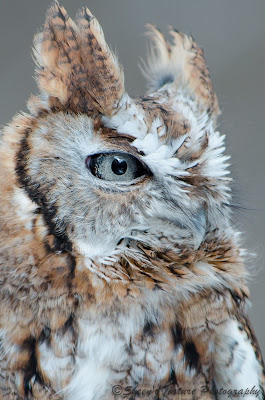 |
Eastern Screech Owl
Nikon 5100, 55-300mm, f/8, ISO 320, 1/320 |
Now that I understood how to operate the camera, I needed to understand how to artistically capture the image. Short, 'how-to photograph' eBooks. They're easy, quick to the points and inexpensive.
The eBook that was instrumental in putting it all together was
Jim Harmer's 60-page book
Improve Your Photography: How Budding Photographers Can Get Pro Results.
At the end of chapter two, I understood how to use my camera as a photographer. By chapter five, I was engaged in wildlife photography. And by chapter six? Hello RAW, bye-bye JPEG. Chapter ten, composition.
These thirteen game-changing chapters inspired me to dive in. Instead of five images, I take many using different settings and angles. Some subjects can easily consume one hundred plus presses of the shutter. To draw out what captivated you to take the picture requires many shutter snaps from multiple perspectives. Thank goodness for digital and a bit of evolving patience!
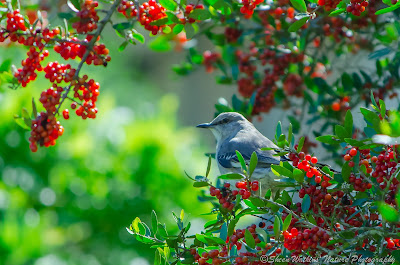 |
Northern Mockingbird April 2012, one of my first images as a photographer
Nikon 5100, 55-300mm, f/5.6, ISO 500, 1/1000 sec |
Since then, I've downloaded more ebooks, talked to other photographers, linked to photographer's Facebook pages and talked extensively with my local camera guys. Dennis, Rick and Roy at
Woodward Camera get involved with where I am at skill-wise and offer insight into decisions. When your camera experts understand you, their suggestions and questions drive better outcomes.
Hint: while there's a time to shop online as there are many diverse resources available, there's definitely a time to shop locally. You are investing in more than a camera, you are investing in you!
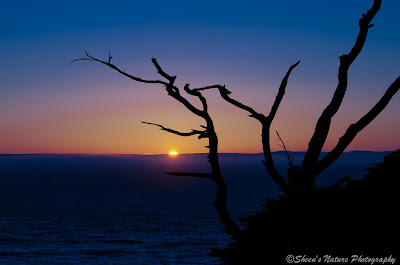 |
Sunset in San Francisco, 2012
Nikon 5100, f/10, ISO 200, 1/320 sec |
Photograph what you love and you'll find the photographer within.
Happy Shooting!

















































